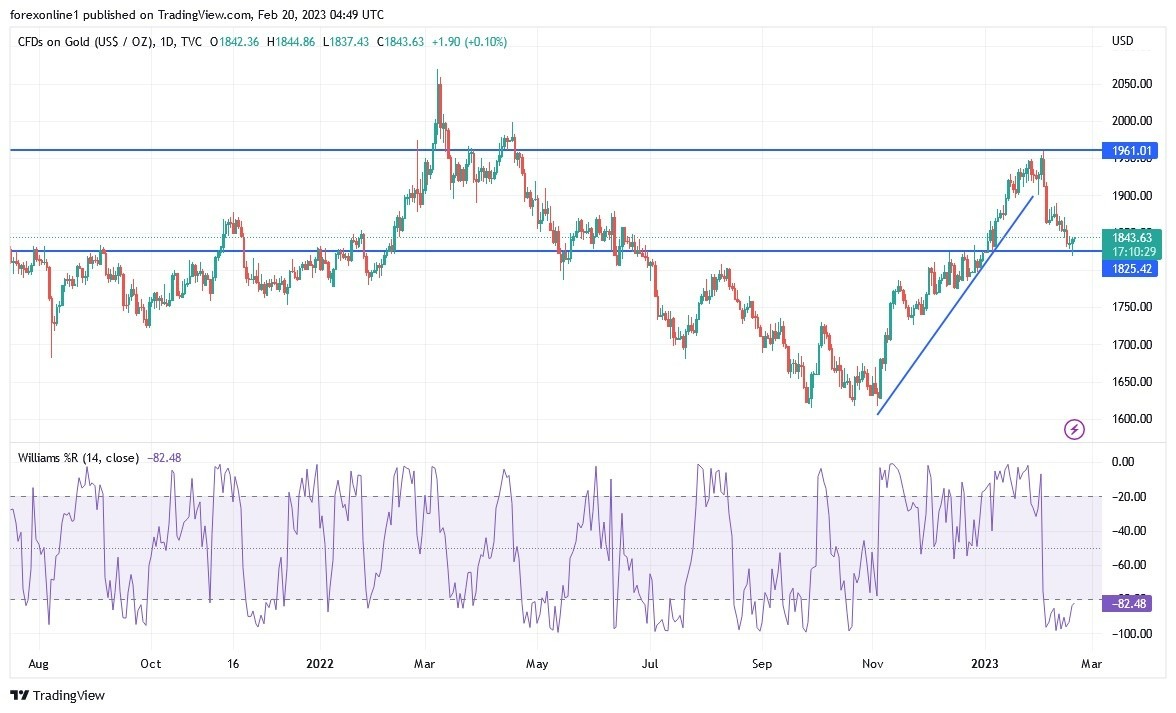Gold futures ended the last trading week above $1,850 an ounce, but prices fell for the third consecutive week as the market prepares for an additional hike in US interest rates. The price of the yellow metal has struggled in conjunction with the broader financial markets due to fears that the US central bank will continue to press the trigger to raise interest rates in its battle to beat inflation.
Gold (XAU/USD) price fell to the support level of $1819 an ounce, the lowest price in nearly two months, and rebounded with the dollar's gains halting, to the level of $1843 an ounce. Accordingly, the price of the precious metal recorded a weekly loss of about 1.2%, reducing its annual gains since the beginning of 2023 to date, to 1.25%.
Gold prices are now trading at their lowest since the end of December. In the same performance, the price of silver, gold's sister commodity, tried to gain some momentum. On Friday, it rose slightly to $21.76 an ounce. However, the white metal posted a weekly decline of 1%, extending its year-to-date loss by 10%.
The main factor for metallic commodities - and global financial markets - is the policy of the US Federal Reserve. While there was some hope that the US central bank might soon hit the pause button on its quantitative easing efforts, the recent wave of inflation data has cast doubt on the inflation-lowering narrative.
St. Louis Fed President James Bullard and Cleveland Fed President Loretta Mester indicated that they called for further rate hikes at this month's FOMC policy meeting, adding that the central bank should raise interest rates.
These comments supported both the US Dollar Index (DXY) and Treasury yields. Where the US dollar index DXY, which measures the performance of the US currency against a basket of other major currencies, tested the level of 104.00 and recorded a weekly gain of 0.3%. The benchmark 10-year yield fell nearly 2 basis points on Friday but is currently trading above 3.82%. In general, a stronger profit is bad for dollar-denominated commodities because it makes them more expensive for foreign investors to buy. In addition, the gold market is sensitive to interest rate fluctuations because it can affect the opportunity cost of holding non-yielding bullion.
The US Consumer Price Index (CPI) came in at a higher-than-expected 6.4% yoy and rose 0.5%, higher-than-expected on a monthly basis. The producer price index eased to 6% (YoY) but rose 0.7% (YoY).
In other metals markets, copper futures fell to $4.1155 a pound. Platinum futures fell to $921.40 an ounce. Palladium futures fell to $1494.50 an ounce.
By the end of last week, US stock indices fell in Wall Street markets and Treasury yields rose after data showed that US producer prices rebounded in January more than expected, which confirms the ongoing inflationary pressures that may push the Federal Reserve to pursue more interest rate increases. According to the official announcement, the producer price index for final demand jumped 0.7 percent last month, the most since June, and rose 6 percent from a year earlier, supported by higher energy costs. After the data was released, Cleveland Fed President Loretta Mester said in prepared remarks that she saw a "compelling economic case" to start another 50 basis point hike earlier this month.
Accordingly, the stocks' gains were erased on Wednesday, as the S&P 500 and Nasdaq 100 fell by 0.5 percent. The yield on the benchmark 10-year Treasury rose at one point to nearly 3.87 percent, the highest level this year. The data picture was mixed. New home building in the US fell for the fifth month in January as higher mortgage rates continued to dampen housing demand, but weekly jobless claims fell to 194,000, below expectations of 200k.
US economic data released last Thursday added more detail to federal policymakers planning the path to raise interest rates after US retail sales jumped in January by the most in almost two years.
Gold Forecast:
- The attempt to recover last Friday did not live up to the price of gold at all to the opportunity to rebound upwards, as the bears' control is still stronger.
- According to the performance on the daily chart below, it is expected that the price of gold will continue to decline to stronger support levels, the closest to which they are currently 1825 and 1790 dollars, respectively.
The last level can be considered buying gold, waiting for the moment of a rebound upwards. On the other hand, and for the same time period, the bulls need to move gold prices to the resistance level of $1882 an ounce to control the trend instead of the current bearish look. Today, a quiet trading session is expected in light of the American holiday.

Ready to trade today’s Gold prediction? Here’s a list of some of the best Gold brokers to check out.

